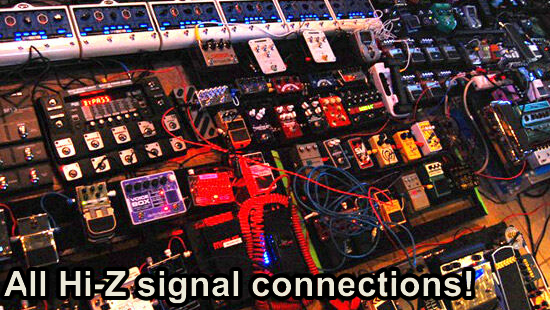Why does a guitar output a high impedance or Hi-Z signal?
Posted: 2 October 2013
Synopsis: A guitar signal is unique because it passes direct from instrument to the amplifier without any pre-amplification. Fluctuations in the 'signal voltage' are used to represent the actual audio, and for this reason the H-Z (high impedance) signal type has 10

A signal produced by the pick ups on an electric guitar is quite weak and measured in millivolts. The fluctuations in the voltage of guitarists signal is what's used to create represent the audio. As a guitarist is connecting directly from the pick ups directly to the input on an amplifier, without any pre-amplification (as would be the case with a microphone signal), it is important that signal is transferred in the strongest possible way.
In an amp to speaker connection, this is achieved by matching the impedances of the amplifier and speaker. Matching impedances allows for maximum 'power' transfer. However in a guitar to amp connection, it is signal 'voltage' fluctuations rather than 'power' that we are looking to maximise. Voltage fluctuations are maximised by having the voltage as high as possible. This is achieved by having a high impedance output on the guitar pick ups (~10,000 / 10k ohm) and an even higher impedance on the guitar amplifier input (1,000,000 / 1M ohm).
 |
A Hi-Z signal can be subject to high frequency loss (usually over 10,000 kHz) due to capacitance from pots / knobs on the guitar and the guitar lead itself. Turning a pot up decreases the capacitance, leading to more high frequency in the signal. In regards to the cable capacitance, guitar leads (whether premium branded or cheaper alternatives) all have a relatively low capacitance, with only very small differences between them. Cable capacitance is really just increased the longer the length of your cable. This is why guitar leads are not generally sold over 15m in length, and a DI box is often used to change a Hi-Z signal to mic level, so it can carried using a balanced microphone cable or multicore over long distances.
The Hi-Z signal type has become the standard for guitar signals not merely because of choice or preference, but through much early experimentation and science. There were the obvious limitations posed by the nature of guitar pick ups, where you are working with a very small passive signal and trying to drive it directly to an amplifier. Household names such as Les Paul and Leo Fender helped pioneer the development of the electric guitar mastering not only the ideal body types but the ideal pick ups electronic setup. Both of which are still incredibly relevant even today and will be for decades to come.
 |






